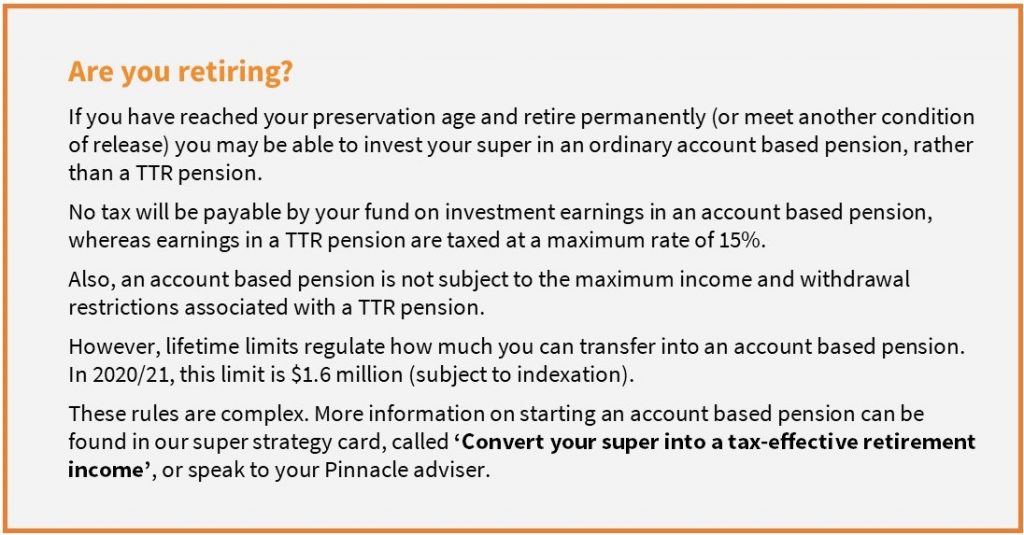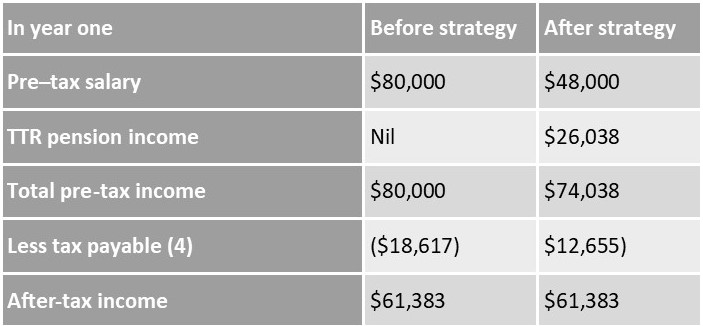If you plan to scale back your working hours, starting a transition to retirement pension could help you to replace your reduced income.
How does the strategy work?
To use this strategy, you need to invest some of your super in a transition to retirement (TTR) pension.
The key benefit of doing this is you can receive an income from the TTR pension to replace the income you’ll forgo when reducing your working hours.
Also, you’re likely to pay less tax on the income you receive from the TTR pension than you do on your salary or business income.
This is because even though the taxable income payments from a TTR pension are taxed at your marginal tax rate, they will attract a 15% tax offset between preservation age¹ and 59. Also, the income payments are tax-free² at age 60 or over.
As a result, you’ll generally need to draw less income from the TTR pension to replace your reduced salary, as the Case study below illustrates.
Other key considerations
There are some key issues you’ll need to consider before starting a TTR pension.
For example:
- you’ll need to draw a minimum income each year, which is 2% of the account balance per annum in 2020/1 and 4% thereafter
- you can’t draw more than 10% of the account balance each year, and
- you can only take a cash lump sum (or purchase a different type of income stream) once you permanently retire, reach age 65 or meet another ‘condition of release’.

Case study
Mark, aged 58, works full-time, earns a salary of $80,000 pa (or $61,383 after tax) and has $400,000 (3) in super. He wants to
cut back to a three-day working week.
While Mark’s salary will reduce to $48,000 pa, he doesn’t want to compromise his living standard.
To help him achieve his goals, his financial adviser suggests he invest his entire super benefit in a TTR pension and draw an
income of $26,038 over the next 12 months.
By using this strategy, he’ll be able to replace his pay cut of $32,000 and continue to receive an after-tax income of $61,383 pa.
He will also pay $5,962 less tax. This is because the TTR income payments attract a 15% tax offset³, whereas his salary is fully taxable at his marginal rate.
Finally, Mark could still achieve his after-tax income goal if he invests as little as $260,038 in the TTR pension and draws the maximum income of $26,038.
However, by investing his entire super balance of $400,000 in the TTR pension, he will have the flexibility to increase his income payments, should he need to, up to the maximum of 10% of the account balance per annum.

Seek advice
Your Pinnacle Adviser can help you assess all the issues that need to be considered and determine whether a TTR pension suits your needs and circumstances.
Any advice provided is of general nature only and does not take into account your objectives, financial situation or needs.
1. Preservation age is 55 for those born before 1 July 1960 and gradually increases to 60 depending on your date of birth.
2. Assumes the TTR pension is commenced from a taxed super fund.
3. Mark’s super benefit consists entirely of the taxable component.
4. The tax payable takes into account the 15% pension tax offset available on taxable pension payments from preservation age to age 59 and the Low and Middle Income Tax Offset as at 1 July 2020.
Source: MLC

